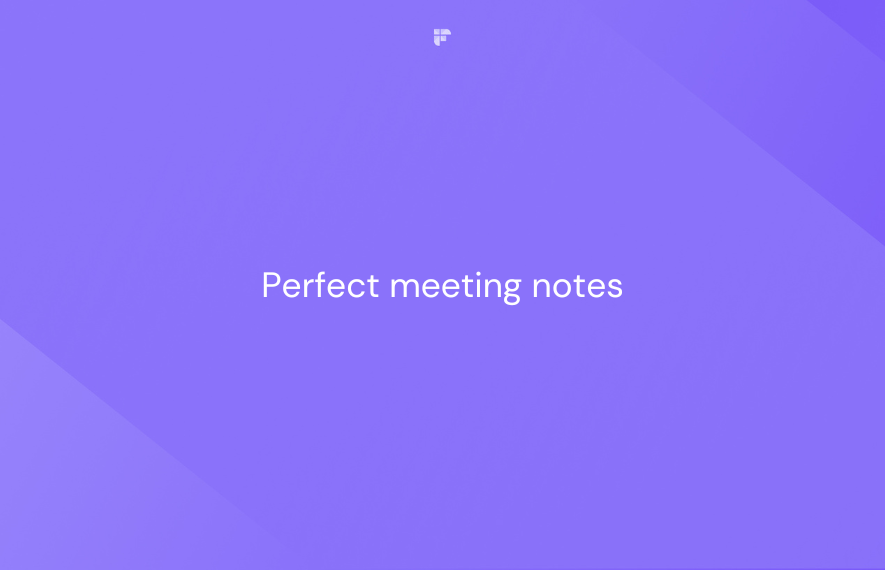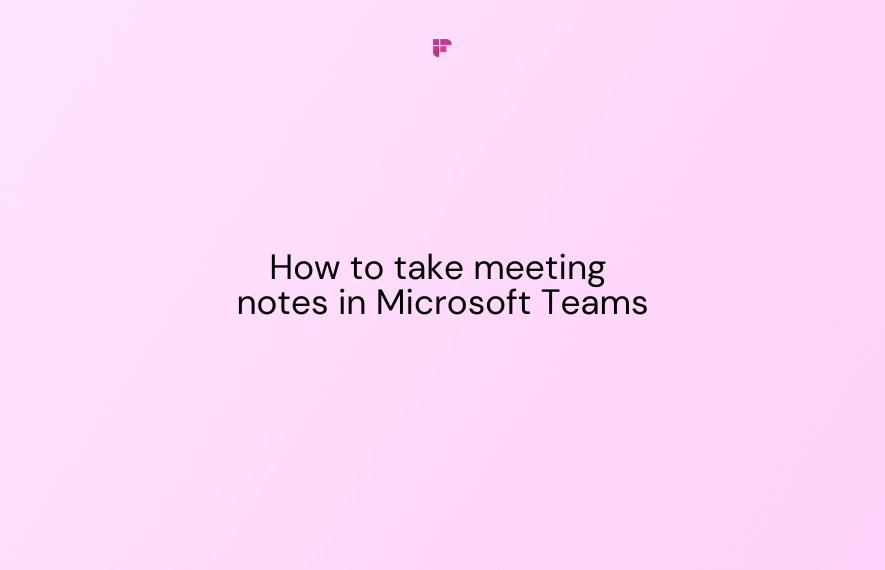Meetings are where teams make decisions, outline strategies, and set action plans. For meetings to be effective, having a great discussion is not enough. It's important to capture what happened in the meeting.
Without proper documentation, even the most productive meetings can lose value, as ideas are forgotten, responsibilities become unclear, and follow-through falters.
This is why knowing how to create effective meeting notes is essential for meeting productivity.
In this article, we'll discuss how you can take perfect meeting notes and some templates and tools to help you automate the process.
Why do meeting notes matter more than you think?
Meeting notes serve as the informal record of the meeting. They are different from meeting minutes, as they serve as a formal record with all comprehensive information of the meeting.
Meeting notes are not as detailed and only stick to the essential things discussed during the meeting.
Here's why meeting notes matter:
Accountability and follow-up
According to Calendly's The State of Meetings 2024 report, we attend at least two meetings daily on average.
With 10+ meetings happening every week, an information overdose is inevitable.
Meeting notes serve as a powerful antidote to this overload. They distill the flood of information into actionable summaries, ensuring no critical point or decision is overlooked. With clearly documented action items, everyone knows their responsibilities, deadlines, and next steps. Following up on tasks becomes easy.
Reference for future meetings
Properly documented meeting notes help teams track long-term progress. It enables them to easily reference previous decisions, providing clarity and continuity as projects evolve.
Key details can easily get lost in the shuffle of multiple meetings. Meeting notes preserve critical information so teams don't stray from their goals.
Better communication
A significant reason for misunderstandings and conflicts between teams is poor communication. It can easily cause losses to the team's overall productivity and reduce their morale. Well-documented meeting notes help minimize this gap by providing a clear record of the meeting, leaving little room for miscommunication.
If someone joins a project midway or misses a meeting due to scheduling conflicts, meeting notes can quickly bring them up to speed.
Main components of meeting notes
- Meeting title: Clearly state the purpose of the meeting.
- Date and time: Record when the meeting took place.
- Location: Specify where the meeting took place or the platform used for virtual meetings. You can also add a link for the team to view the full recording if available.
- Attendees and absentees: List who was present in the meeting and who was not.
- Agenda items: Outline the topics discussed during the meeting.
- Main discussion points: Summarize key discussions for each agenda item.
- Decisions made: Document any decisions reached during the meeting.
- Action items: Clearly define tasks assigned to attendees, including deadlines.
The level of detail can vary depending on the type of meeting, but including these components in your meeting notes can make them consistent and easy to understand.
💡 Focus on the conversation and let Fireflies handle notetaking!
Fireflies records, transcribes, and summarizes your meetings. It automatically generates meeting notes so you can participate in the conversation instead of jotting down meeting notes.
Tips to take perfect meeting notes
1. Before the meeting
Prepare before the meeting
Preparation is the foundation of writing clear meeting notes. Getting things ready before the meeting begins helps you focus on key discussions and capture relevant details.
Before the meeting, read any materials that will be discussed, such as reports, proposals, or notes from previous meetings. This context will help you understand the discussions better and faster.
If it is a series of meetings, reread the notes from the last meeting to refresh your memory and identify any ongoing items that may arise.
Understand the purpose of the meeting
Look for an agenda to get an overview of topics for discussion and presentation.
Identify the meeting's aims. Are you trying to make decisions, brainstorm ideas, or review progress?
Know your role as the note-taker
If you're the designated notetaker, understand what's expected of you. Are you summarizing key points for internal use or creating notes to share with external stakeholders?
With this in mind, discuss with the meeting organizer for any specifics they would like to capture, such as explicit action items and decisions.
Preliminary structure
Before taking notes, create an outline for notetaking. Divide your document into sections, including the title of the meeting, the date, attendees, agenda items, key discussion points, decisions, and action items. This will help you stay organized so you don't miss critical information during the meeting.
Set up your tools
Use the correct tools to make the job of taking meeting notes easier. An AI notetaker like Fireflies.ai helps you record, transcribe, and summarize the meeting. You can also use tools like Google Docs, Notion, and Evernote to create notes as the meeting progresses.
If you like taking notes on paper, keep your notebook or structured template in front of you.
Advanced testing
Make sure the platform (Zoom, Google Meet, Teams, or something else) works fine for virtual meetings. Critically check the audio quality and internet connectivity beforehand to avoid disruptions in the middle of the meeting.
2. During the meeting
Plan to stay engaged
Effective notetaking hinges on active listening. Come prepared for the meeting and focus on highlighting all key points rather than trying to catch every word. Turn off notifications and avoid distractions to pay full attention to the discussion.
Use bullet points
Instead of capturing every detail of the meeting, write short bullet points that capture the essence of the discussion. This will make your notes easier to scan and take less time to review after the meeting.
Identify action items and important points
Write down every specific task or responsibility mentioned during the meeting. Make sure the description is clear and concise, avoiding any ambiguity. For example, instead of writing "Prepare report," note "Prepare a Q4 financial summary report."
Identify and document who is responsible for completing each action item. If the task has a timeline or deadline, include it next to the action item.
Using the example above, the action item can be rewritten as follows: "John Smith will prepare a Q4 financial summary report by January 20th."
If some action items are urgent or particularly critical, mark them as high-priority so the responsible person knows to address them promptly.
3. After the meeting
Revise your notes
Once the meeting is over, take some time to review and refine your notes. Contact the relevant participants immediately if any action items, responsibilities, or deadlines appear unclear or incomplete.
Additionally, check the accuracy of your notes so that they fully capture the meeting's discussions, decisions, and next steps.
Highlight key takeaways
Emphasize the key takeaways like major decisions, significant discussion points, and overall conclusion in your meeting notes. Summarize these points succinctly, as they are the most referenced part of your notes for those reviewing them later.
Share meeting notes
Once your meeting notes are finalized and thoroughly reviewed, promptly share them with your team or relevant stakeholders. Clearly label the document with the meeting's title, date, and relevant context to make it easy to reference later.
Templates for perfect meeting notes
- Standard Meeting Notes Template
- Project-Specific Meeting Notes Template
- Strategy Planning Meeting Notes Template
- Problem-Solving Meeting Notes Template
1. Standard Meeting Notes Template
This basic structure works well for most meetings:
Download template:
2. Project-Specific Meeting Notes Template
Download template:
3. Strategy Planning Meeting Notes Template
Download template:
4. Problem-Solving Meeting Notes Template
Download template:
Tools for taking better meeting notes
Fireflies.ai: Best AI notetaker for automated meeting notes
Forget the stress of frantic notetaking and let AI handle the task for you. Fireflies.ai seamlessly joins virtual meetings on platforms like Zoom, Microsoft Teams, and Google Meet.
It records, transcribes, and automatically creates meeting notes of conversations. You and your team can easily review discussions and action items without replaying the entire recording.
Fireflies creates structured meeting notes for every meeting, which include keywords, overview, action items, and bullet-point notes.
Key features:
- Automatically share meeting notes with relevant people as soon as the meeting ends.
- Automatically extract and assign tasks to relevant team members.
- Use 100+ AI App templates, including the BANT Sales App, Competitor Analyzer, Risk Analyzer, Feedback Analyzer, and more, to create custom meeting notes and insights.
- Create and share small audio soundbites of important sections of your meetings.
- Collaborate on the transcript by adding time-stamped bookmarks and comments.
- Use Smart Search to quickly filter the transcript by questions, tasks, sentiments, speakers, etc.
- Use ChatGPT-like AI Assistant AskFred to get answers to all your meeting-related questions.
- Use Topic Trackers to keep track of important topics across your meetings.
- Easily search through all your meetings to find relevant details quickly.
Useful digital notetaking tools for manual notes
- Evernote: Includes customizable templates that help structure notes. It’s helpful for informal meetings, such as brainstorming sessions, where actionable takeaways matter.
- Notion: A data management platform where you can create databases for notes and track action items and decisions over time.
- Google Docs: A simple option that allows for real-time collaboration where many team members can chime in, either during or after meetings.
Key takeaways
The right tools and templates for meeting notes can transform meetings into productive, action-driven sessions. But whether you use digital tools like Notion or write notes out old-school by hand, the trick to notes is clarity and structure. Or, you can start using an AI notetaker like Fireflies and free yourself from ever having to take notes again.
Remember, effective meeting notes aren't just about documentation—they are about clarity, accountability, and driving progress.






